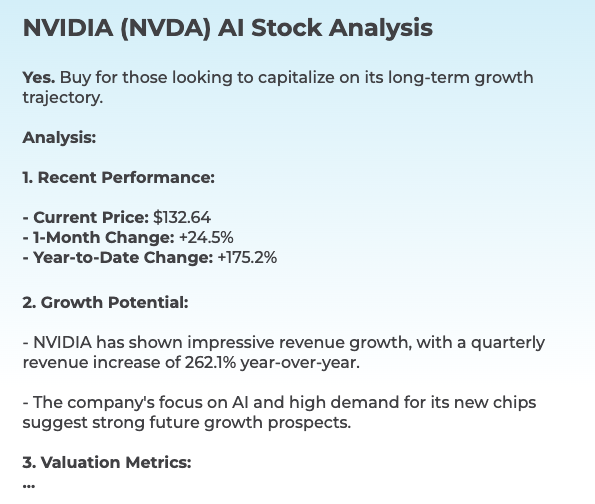20 Great Advice To Deciding On AI Stock Predictions Analysis Sites
Wiki Article
Top 10 Things To Consider When Evaluating Ai And Machine Learning Models On Ai Trading Platforms
In order to obtain accurate, reliable and useful insights, you need to test the AI models and machine learning (ML). Incorrectly designed or overhyped model can lead financial losses and flawed forecasts. Here are the 10 best strategies for evaluating AI/ML models on these platforms.
1. Learn the purpose of the model and its Method of Approach
Determining the objective is important. Make sure the model was designed for long-term investing or trading in the short-term.
Algorithm transparency: Check if the platform provides information on the kinds of algorithms utilized (e.g. regression, decision trees, neural networks or reinforcement learning).
Customizability - Determine if you can tailor the model to suit your investment strategy and risk tolerance.
2. Review model performance by analyzing the metrics
Accuracy: Make sure to check the model's prediction accuracy however, don't base your decision solely on this measure, since it could be misleading in financial markets.
Recall and precision. Evaluate whether the model accurately predicts price movements and minimizes false-positives.
Risk-adjusted gain: See if the predictions of the model result in profitable transactions, after taking into account the risk.
3. Test the model by Backtesting
Performance historical: Test the model with previous data and determine how it will perform in previous market conditions.
Tests with data that were not intended for training: To avoid overfitting, test your model with data that has not been previously used.
Analyzing scenarios: Examine the model's performance in different market conditions.
4. Check for Overfitting
Overfitting: Watch for models that work well with training data, but do not perform well with unseen data.
Regularization techniques: Determine the application uses techniques like L1/L2 regularization or dropout to avoid overfitting.
Cross-validation is essential: the platform should utilize cross-validation to assess the generalizability of the model.
5. Examine Feature Engineering
Important features: Make sure that the model has relevant attributes (e.g. price or volume, as well as technical indicators).
Feature selection: Ensure the platform chooses characteristics that have statistical significance, and avoid redundant or irrelevant information.
Dynamic updates of features Check to see if over time the model adapts itself to the latest features or market changes.
6. Evaluate Model Explainability
Model Interpretability: The model should be able to provide clear explanations for its predictions.
Black-box model Beware of platforms that make use of models that are overly complicated (e.g. deep neural network) without describing the methods.
User-friendly insight: Determine whether the platform is able to provide useful insight to traders in a way that they can comprehend.
7. Assess Model Adaptability
Market conditions change - Check that the model can be adapted to changes in market conditions.
Continuous learning: Make sure that the system updates the model often with fresh data to improve the performance.
Feedback loops - Ensure that the platform integrates real-world feedback as well as user feedback to enhance the model.
8. Check for Bias and Fairness
Data biases: Make sure that the data for training are valid and free of biases.
Model bias: Ensure that the platform actively monitors model biases and reduces them.
Fairness. Check that your model doesn't unfairly favor certain industries, stocks, or trading methods.
9. Calculate Computational Efficient
Speed: Check whether the model can make predictions in real time, or at a low delay. This is crucial for traders who trade high-frequency.
Scalability: Check whether the platform can manage several users and massive datasets without performance degradation.
Resource usage: Make sure that the model is optimized to make the most efficient use of computational resources (e.g. GPU/TPU use).
Review Transparency Accountability
Model documentation - Make sure that the platform has detailed information about the model, including its architecture the training process, its limitations.
Third-party Audits: Check whether the model was independently audited or validated by third parties.
Error handling: Check that the platform has mechanisms to detect and fix models that have failed or are flawed.
Bonus Tips
User reviews and Case studies: Review user feedback, and case studies in order to assess the performance in real-world conditions.
Trial period: Test the model free of charge to see the accuracy of it and how easy it is to utilize.
Customer Support: Ensure that the platform offers solid technical or model-specific assistance.
If you follow these guidelines, you can assess the AI/ML models used by stock prediction platforms and make sure that they are reliable transparent and aligned with your goals in trading. Read the top a fantastic read for ai trade for site examples including chatgpt copyright, ai stock trading, chart ai trading assistant, ai for trading, ai stock trading, investment ai, ai for investing, ai investment platform, ai for stock predictions, ai investing app and more.

Top 10 Tips To Evaluate The Social And Community Capabilities Of Ai Stock Trading Platforms
In order to better understand how users interact, learn and share it is essential to analyze the social and community aspects of AI-driven stock trading platforms. These features enhance the user experience by offering valuable assistance. Here are 10 top suggestions to help you assess the community and social features of these platforms.
1. Active User Community
Tip: Ensure the platform is active and has users who are regularly participating in discussions, sharing information, or providing feedback.
Why: A lively community is a place where members can learn and grow together.
2. Discussion forums and boards
TIP: Check the quality and amount of participation on message boards or forums.
Why? Forums allow users to ask questions, discuss strategies and market trends.
3. Social Media Integration
Tip: Determine whether the platform you are using allows you to share insights and updates through social media channels such as Twitter or LinkedIn.
Why: Social media integration can enhance engagement and provide real-time market updates.
4. User-Generated Materials
Tip: Look for options that let users create and share content for example, blogs, articles or trading strategies.
Why: User-generated content fosters the spirit of collaboration and gives diverse perspectives.
5. Expert Contributions
Tips - Make sure the platform has contributions from industry experts like market analysts or AI specialists.
Expert opinions add depth and credibility to community discussions.
6. Real-time chat and messaging
TIP: Find out if users can communicate with one another immediately using real-time messaging or chat.
Why: Real time interaction allows quick information sharing and collaboration.
7. Community Moderation and Support
TIP: Check the level of moderation and support provided in the community (e.g., moderators, support staff, etc.).
Why Positive and respectful environment is created by effective moderated behavior, and customer assistance quickly solves issues for users.
8. Events and webinars
Tip - Check to see if the platform offers live Q&A sessions with experts, webinars and other events.
Why: These meetings provide an excellent opportunity to gain knowledge and meet directly with industry professionals.
9. User Reviews
Consider options that offer users to give feedback and comments on the platform or its community features.
What is the purpose: Feedback from users are used to determine strengths and areas for improvement within the community ecosystem.
10. Rewards and gaming
Tips: Determine whether the platform has games elements (e.g., leaderboards, badges) or rewards for active participation.
Gamification is an effective tool that helps users engage more with their friends and with their platform.
Bonus Tip Security and Privacy
Make sure you use strong security and privacy measures for the community and social features. This will help protect your data and interactions.
It is possible to evaluate these elements to see if you are able to find a platform that has a friendly active community that can help you improve your knowledge and skills in trading. See the recommended ai stock predictions for blog examples including best ai for stock trading, chart analysis ai, investing with ai, best ai stock prediction, ai share trading, ai stock investing, stock predictor, best ai stocks, ai stock investing, ai stock analysis and more.
